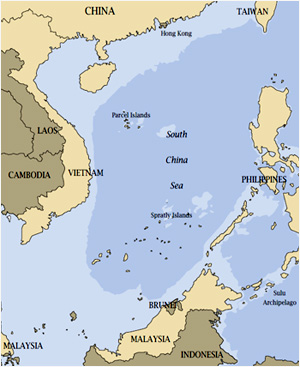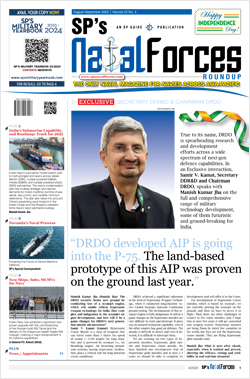INDIAN ARMED FORCES CHIEFS ON OUR RELENTLESS AND FOCUSED PUBLISHING EFFORTS

The insightful articles, inspiring narrations and analytical perspectives presented by the Editorial Team, establish an alluring connect with the reader. My compliments and best wishes to SP Guide Publications.

"Over the past 60 years, the growth of SP Guide Publications has mirrored the rising stature of Indian Navy. Its well-researched and informative magazines on Defence and Aerospace sector have served to shape an educated opinion of our military personnel, policy makers and the public alike. I wish SP's Publication team continued success, fair winds and following seas in all future endeavour!"

Since, its inception in 1964, SP Guide Publications has consistently demonstrated commitment to high-quality journalism in the aerospace and defence sectors, earning a well-deserved reputation as Asia's largest media house in this domain. I wish SP Guide Publications continued success in its pursuit of excellence.
South China Sea
Tension Boils Over the Narrow Waters

It is the major route for importing energy and exporting goods for the east asian countries. singapore and hong Kong have become major global economic hubs. Conflicting territorial claims, piracy, poaching and threat from terrorism have become a matter of concern for all sea-faring nations of the region. It also has large amounts of hydrocarbon resources, which has also escalated regional conflicts.
The South China Sea has great strategic importance as it covers China and connects Indian Ocean with the Pacific Ocean. South China Sea extends from the Strait of Malacca in the south-west to the Strait of Taiwan in the north-east. The littoral or near littoral states include China, Taiwan, Philippines, Malaysia, Brunei, Indonesia, Singapore, Cambodia, Thailand and Vietnam. It is also one of the world’s busiest international sea-lanes providing movement to almost 50 per cent of the world’s oil tanker traffic and the world’s merchant fleet’s tonnage through its waters annually. It is the major route for importing energy and exporting goods for the East Asian countries. Singapore and Hong Kong have become major global economic hubs. Conflicting territorial claims, piracy, poaching and threat from terrorism have become a matter of concern for all sea-faring nations of the region. It also has large amount of hydrocarbon resources which has also escalated regional conflicts. These concerns are increasing due to the following reasons:
- The volume of shipping traffic is increasing day by day
- Safeguarding of exclusive economic zone (EEZ) by the littoral states
- Increased threat of piracy due to the large volume of maritime traffic
- Terrorist threats
- Greater international scrutiny of ports and shipping
The narrow waters of the South China Sea are shared by many nations which have very high population of about 500 million and that make convergence of views on subjects like anti-terrorism measures, safe navigation, anti-piracy measures, prevention of pollution, prevention of human trafficking, EEZ, etc very difficult. Coastal states like China, Indonesia, Malaysia, Singapore and international user states like Australia, India, Japan, and the US have diverse interests in the South China Sea and thus there is a difference of opinion on the methods to achieve maritime security in the region.
Exclusive Economic Zone (EEZ)
Coastal states like Indonesia, Malaysia, Vietnam and China want to protect their EEZ which covers an area up to 200 nautical miles (about 370 km) from the land mass.
Freedom of Movement
International user states like Australia, India, Japan and the US want freedom of safe and secure movement for their merchant and naval fleet through the region. Singapore is a coastal state with a very small coastline but as it is a major global economic hub, hence the convergence of goals with other countries like the US and India regarding freedom of safe and secure movement through the South China Sea.
China
China has a large coastline and extensive EEZ claims. It is also emerging as a global military and economic power. It has a large requirement of energy, which is imported and moves through South China Sea. It also is a major exporting country and owns a large merchant fleet. Thus free access to sea lines of communications in the South China Sea is of vital interest to China. Movement of voluminous maritime traffic requires protection of the environment as well as controlling pollution. Safeguarding individual maritime interests has also triggered a naval arms race to modernise force levels both for the Navy and the Coast Guard. Movement of multinational dense maritime traffic in the South China sea also require a fresh look at the traditional idea of ‘freedom of the seas for all’ to ‘management of the seas’.
United States
The US interest in the South China Sea is based on maintaining its freedom of navigation and global war on terrorism. what has not been said but is understood is the US interest in China and Taiwan. South China Sea links the Pacific Ocean and Indian Ocean and as such the US uses it to move their warships from the Pacific fleet for military missions to the Arabian Sea and the Persian Gulf. The route also connects close allies of the US like Japan to safely move their energy needs from the Middle East. However, the US also follows a policy of active neutrality, which implies that it will remain neutral on local territorial disputes, prevent use of force in settling them and would not allow any actions which will threaten peace in the region. Such ‘active neutrality’ is bound to move the US on a path of conflict with China and especially when its Pacific Fleet is the largest naval command in the world with 190 ships, about 1,400 Navy and Marine Corps aircraft, and 35 shore installations.
The US also maintains that terrorist threat from the sea is as real as the threat from land and air. Jamaah Islamiyah (JI) is a menace in the region.
The Bush administration had launched three major international maritime security initiatives i.e. the Container Security Initiative (CSI), the Proliferation Security Initiative (PSI), and the Regional Maritime Security Initiative (RMSI). CSI and PSI are applicable globally but RMSI is aimed specially for the strait of Malacca. A large number of nations have accepted CSI but there is great opposition to the other two. India has got concerns of its own in joining these initiatives.
In contrast, RMSI has raised the hackles of nations around the South China Sea. The initiative briefly involved high speed vessels embarked with the US Special Operations Forces to carry out interdiction. Countries like Malaysia and Indonesia summarily rejected the proposal of the US intervention and stated that they have enough capability to manage on their own. Any interdiction carried out by foreign troops in the Malacca Straits will not be accepted. The US then offered the view that their proposal has been misunderstood and it involved only the sharing of intelligence. The US Navy then started joint anti-terrorism bilateral exercises with other friendly countries in the region like Singapore and the Philippines in the South China Sea as an alternative. It also gave them an excuse to make their presence in the region.
Japan
Japan has several vital interests in safeguarding the sea lanes of the South China Sea. It is a major player in international trade and is the association of South East Asian Nations (ASEAN) fourth trading partner after China, the United States, and the European Union. Almost all of Japan’s oil supply is imported from the Middle East through the South China Sea. It imports 99 per cent of its petroleum and 70 per cent of its food by sea. Ships carry 99 per cent of Japanese exports by volume. Thus Japan sees maritime security as an integral part of its comprehensive security strategy.
Japan is a member of the PSI and has been holding regular joint exercises. Japan has also initiated its own proposal to combat piracy and maritime terrorism threats by having an ocean peacekeeping fleet to conduct multinational naval and coast guard patrols. This was generally opposed by many South-eastern states. However, Singapore was most responsive. China opposed the proposal because it felt that this may be a cover by Japan to expand its own naval presence make up for decline in the US Navy patrols and to counter China’s control in South East Asia.
However, two other proposals have found favour. First is the establishment of the Asia Maritime Security Initiative (AMARSECTIVE). This provides for regional technical assistance and information sharing. The second is the Regional Cooperation Agreement on Anti-Piracy in Asia (ReCAAP) aimed at preventing and responding to piracy and armed robbery against ships as well as strengthening cooperation among member countries in the areas of information sharing, capacity building and operations. Many countries including India and China have ratified the agreement. Also Japan’s efforts in working with other South China Sea littoral states to combat piracy and terrorism have generally been accepted.





